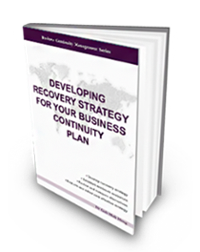What is Business Continuity Strategy?
Disaster Lifecycle
Before developing the BC strategy, it is important to understand the overview of a typical disaster's lifecycle. 
Lifecycle of a Disaster
You will need to ask some basic questions for each phase of the lifecycle.
Reduce (or Prevent)
- Have all threats been identified and their effects minimized?
- Have the appropriate countermeasures been implemented?
- Have all pre-disaster preventive measures been taken?
Respond
- What should the team do while waiting either for the situation to be assessed or for the decision to activate the plan?
- What has been considered as the immediate emergency response?
Recover
- What steps or alternative processing procedures may be taken to work around the problem until it is fixed?
- What are the immediate actions to be taken for time-sensitive business functions?
Resume
- How are the critical business functions going to be operated at another location?
- How are contracted equipment and third-party resources to be acquired?
Restore
- What must the team do if operations must stop because continuing the operations may corrupt or destroy future work or processes?
- What methods will be used to process or catch up on work that has been deferred?
Return
- How do we stop the recovery operations and resume normal business?
How to Develop a Business Continuity Strategy?
The BC strategy building block includes formulating, selecting, and implementing methods to reduce the impact of disasters and respond to incidents.
To achieve the organization's goals and objectives, the strategies to be developed must support each subsequent phase of the disaster lifecycle, namely, response, recovery, resumption, restoration, and return (home).
Each strategy must:
- Be attainable
- Have a high probability of success
- Be verifiable via exercises
- Support timely response and resumption activities
- Meet recovery service objectives
- Be cost-effective
For any given plan, multiple strategies may be developed to address variations, including:
- Probable duration or type of outage
- The business cycle in which the disaster occurs
- Availability of resources
For example, the BC strategy to resume operations from an outage during a peak production period may call for a hot standby facility. An alternative approach for the same facility or business operation in times of lower production demand could be sub-contracting or outsourcing the production.
Depending on the plan's scope, recovery strategy development can be a complex process of defining and analyzing alternative business methods. There is a need to:
- Research and select alternative technology, processes and skillsets
- Evaluate the successes and failures of other organizations using similar approaches
- Determine which alternate site providers can provide the most comprehensive service and the acceptable level of coverage for implementing the selected strategies.
- Select a strategy that provides an acceptable level of service and cost-benefit
Remembering strategies may differ even for organizations within the same industry is essential.
TIPs: Depending on the cost and exposure of the recovery strategy, it may be necessary even to adopt a temporary recovery strategy to address a portion of the organization’s recovery needs until issues such as funding and system re-engineering are resolved.
Required Knowledge
Developing the recovery strategy becomes less complicated as a BCP Project Manager gains experience. During the initial learning period, a BCP Project Manager could learn from seasoned business continuity professionals to ensure that the developed BC strategy is viable.
The BCM Project Manager must have a solid knowledge of viable options and alternatives in crisis management, alternate site selection, and telecommunications. Knowledge of data processing and vital records retention will also prove extremely useful in developing the BC strategies.
Objectives of BC Strategy Phase
The objectives of the BC strategy phase are to:
- Establish business functions and job priorities vis-à-vis business needs
- Determine processing requirements for priority business functions
- Identify and formalize backup for everything needed to survive a disaster
- Ensure that an alternative processing procedure is available for the continuity of critical business needs whilst recovery is in progress
Tasks
The tasks to complete this recovery strategy phase include the following:
- Analyze all business functions and prioritize them based on business needs
- Analyze critical resources required to run high-priority business functions so that sufficient backup can be arranged
- Review and establish backup arrangements, if necessary
- Identify necessary interim processing procedures for critical business functions
- Seek management’s review and endorsement of findings and recommendations
What Does BC Strategy (BCS) Development Entail?
The entire BC strategy process involves the following stages:
Stage 1: Initiate BCS Project and Design
- Understand the development process for BC strategy
- Evaluate current status and arrangement
- Prepare project plan
Stage 2: Develop and Consolidate Strategy
- Design working document
- Conduct workshop
- Design and develop BC strategy
- Review and consolidate submissions from business units
Stage 3: Finalise BC Strategy & Obtain Acceptance
- Validate design
- Finalize strategy
- Obtain management approval
Expected Deliverables
The expected deliverables at each stage of a typical Recovery Strategy phase are based on developing:
- Strategic plans for recovering prioritized business functions
- Critical business functions requiring interim manual processing procedures
- Alternative interim processing procedures
Reference
 Goh, M. H. (2021). Developing Business Continuity Strategy for Your Business Continuity Plan. Business Continuity Management Planning Series (3rd ed.). Singapore: GMH Pte Ltd.
Goh, M. H. (2021). Developing Business Continuity Strategy for Your Business Continuity Plan. Business Continuity Management Planning Series (3rd ed.). Singapore: GMH Pte Ltd.
Extracted from "Chapter 2: What is Recovery Strategy?"
More Information About Blended Learning BCM-5000 [BL-B-5]
To know more about our blended learning program and when the next course is scheduled, feel free to contact our friendly course consultant colleagues via sales.ap@bcm-institute.org. They are the BL-B-3 Blended Learning BCM-300 ISO22301 BCMS Implementer and the BL-B-5 Blended Learning BCM-5000 ISO22301 BCMS Expert Implementer.
![FAQ [BL-B-3]](https://no-cache.hubspot.com/cta/default/3893111/b3824ba1-7aa1-4eb6-bef8-94f57121c5ae.png) |
Please feel free to send us a note if you have any of these questions to sales.ap@bcm-institute.org |
 |









